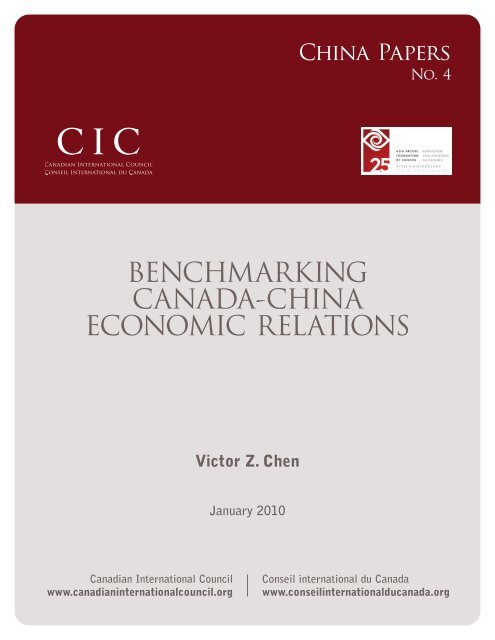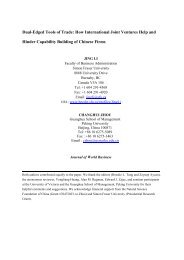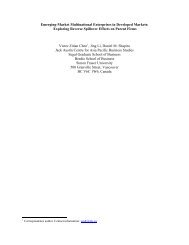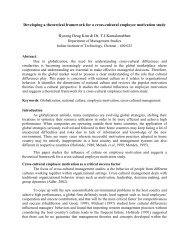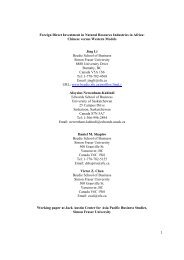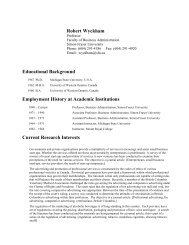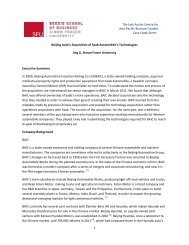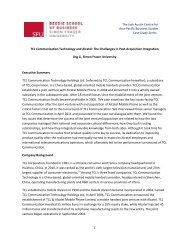benchmarking canada-china economic relations - Asia Pacific ...
benchmarking canada-china economic relations - Asia Pacific ...
benchmarking canada-china economic relations - Asia Pacific ...
You also want an ePaper? Increase the reach of your titles
YUMPU automatically turns print PDFs into web optimized ePapers that Google loves.
BENCHMARKING<br />
CANADA-CHINA<br />
ECONOMIC RELATIONS<br />
Canadian International Council<br />
www.canadianinternationalcouncil.org<br />
Victor Z. Chen<br />
January 2010<br />
China Papers<br />
No. 4<br />
Conseil international du Canada<br />
www.conseilinternationaldu<strong>canada</strong>.org
China Papers No. 4<br />
Abstract<br />
This paper benchmarks Canada’s bilateral <strong>economic</strong> ties with China and compares them with those of other G7<br />
member countries, plus Australia. It uses a gravity model of <strong>economic</strong> flows to compare actual import, export<br />
and investment levels to those predicted by the model. This shows that, in the period 2003-2006, Canada was<br />
under-performing in terms of all bilateral <strong>economic</strong> flows except its outward foreign direct investment to China.<br />
In comparison with other G7 countries and Australia, Canada has under-weighed China as an international partner<br />
except in its imports from that country. The predicted values for all bilateral <strong>economic</strong> variables suggest that<br />
China should be Canada’s second most important partner in terms of all bilateral <strong>economic</strong> flows, except for<br />
those with the United States.<br />
Résumé<br />
Cette étude propose une analyse comparative des liens économiques bilatéraux entre le Canada et la Chine par<br />
rapport à ceux des autres pays du G7 et de l’Australie. À l’aide d’un modèle gravitationnel des flux économiques,<br />
on y compare les niveaux réels d’importations, d’exportations et d’investissements aux pronostics du modèle.<br />
On établit ainsi que pour la période 2003-2006, le Canada a affiché un rendement inférieur au chapitre de tous<br />
les flux économiques bilatéraux, sauf pour ses investissements extérieurs directs en Chine. Par rapport aux<br />
autres pays du G7 et à l’Australie, le Canada a ainsi fait une moindre place à la Chine en tant que partenaire<br />
international, excepté pour ses importations en provenance de ce pays. Selon les valeurs prévues de toutes les<br />
variables économiques bilatérales, la Chine devrait pourtant être le deuxième partenaire du Canada pour ce qui<br />
est de l’ensemble des flux économiques bilatéraux, précédée seulement par les États-Unis.<br />
About the Author<br />
Victor (Zitian) Chen is a PhD Candidate in Strategy at the Segal Graduate School of Business, Simon Fraser<br />
University. He wrote this paper as part of his tenure as a Post Graduate Research Fellow at the <strong>Asia</strong> <strong>Pacific</strong><br />
Foundation of Canada, 2008-2009. His research interests cover emerging economies, the <strong>Asia</strong>-<strong>Pacific</strong> gateway,<br />
international investment and migration, as well as public-private partnership, corporate governance and institutional<br />
development. His work has been presented at Academy of Management meetings, Academy of International<br />
Business meetings, the Canadian Socio-Economic Conference and the Canadian Population Society Conference,<br />
among others. He is a recipient of British Columbia <strong>Pacific</strong> Century Scholarship 2007-2008 and SSHRC 2009-2011<br />
Doctoral Scholarship. Victor holds an MA in Economics from the University of Ottawa and a BA in Finance from<br />
Beijing, China.<br />
The opinions expressed in this paper are those of the author and do not necessarily reflect the views of the<br />
Canadian International Council, its Senate or its Board of Directors.<br />
If you would like to download a copy of this report please visit www.canadianinternationalcouncil.org<br />
If you would like to be added to our mailing list or have questions about our publications please contact:<br />
info@canadianinternationalcouncil.org<br />
ISSN 1921-9865 (Online) ISSN 1921-9881 (Print)
China Papers No. 4<br />
The purpose of this paper is to benchmark Canada-China bilateral <strong>economic</strong> <strong>relations</strong> by comparing their<br />
2003-2006 performance with those of 103 major economies, with particular focus on G7 members plus<br />
Australia. I utilize the gravity model in international <strong>economic</strong>s to predict Canada and other nations’ bilateral<br />
<strong>economic</strong> flows with China, and to calculate the extent to which each nation’s actual flows deviate from<br />
their predicted values. Consequently, I can benchmark and rank Canada-China bilateral <strong>economic</strong> <strong>relations</strong><br />
based on the deviations from predicted bilateral <strong>economic</strong> flows compared to other nations. The gravity<br />
model in international <strong>economic</strong>s predicts bilateral <strong>economic</strong> flows based on the <strong>economic</strong> size of, and distance<br />
between, two partners. The model was first used by Walter Isard in 1954, and has been extensively used<br />
to explain and predict bilateral flows of exports, imports and foreign direct investments (FDI).<br />
The gravity model relates bilateral <strong>economic</strong> flows positively with two partners’ <strong>economic</strong> size, often<br />
measured as real gross domestic product (GDP), and distance between them as calculated in formula (1).<br />
Where V i,j,t denotes predicted bilateral <strong>economic</strong> flows (exports, imports, inward FDI and outward FDI)<br />
between partner i and partner j in time period t; β1 and β 3 suggest positive parameters for the impact of<br />
partners’ <strong>economic</strong> sizes on predicted bilateral <strong>economic</strong> flow; β 2 suggests the impact of distance between<br />
two partners on bilateral <strong>economic</strong> flow; θ is a constant term, which is neither related to either partner’s<br />
<strong>economic</strong> size, nor related to distance between them. All parameters are usually assumed to stay<br />
unchanged in the short run.<br />
It is usual to assign value 1 to β 3 if country i is treated as the only polar, as is the case in this paper<br />
in which China is treated as the only polar. Namely, I compare bilateral <strong>economic</strong> flows between Canada<br />
and China with those between other countries and China. Consequently, the basic gravity model becomes<br />
which can be further transformed to<br />
or a logarithm-logarithm form as<br />
Therefore, if I know the values of the constant term parameter and parameters for <strong>economic</strong> size and<br />
distance, I can calculate the predicted value of bilateral <strong>economic</strong> flows between partner i and partner j<br />
in time period t, and thus can calculate the extent to which actual values deviate from what is predicted.<br />
By comparing the difference between actual and predicted values of each country’s bilateral <strong>economic</strong><br />
flows with China, I can rank Canada’s performance.<br />
– 1 –<br />
(1)<br />
(2)
China Papers No. 4<br />
To get the values for all parameters, my strategy is to regress model (2) using the most recent<br />
historical data of a sufficiently large sample. Given that each country’s measurement for reporting statistics<br />
of bilateral <strong>economic</strong> <strong>relations</strong> may differ, and thus may be inconsistent for making a comparison, I have<br />
collected all data from a single country’s official statistics. As China is the polar for our comparison, I<br />
collected data on China’s bilateral <strong>economic</strong> flows, including exports, imports, inward FDI and outward<br />
FDI, with all other countries in the world between the years 2003 and 2006 from the National Bureau of<br />
Statistics of the People’s Republic of China (Stat China). The major reason for picking this time period is<br />
that 2003 is the first year and 2006 is the most recent year available when data was publicly released for<br />
all of the needed bilateral <strong>economic</strong> flows. I collected real GDP data (measured as GDP in purchasing<br />
power parity (PPP)) from the World Bank and distance measures from Centre D'études Prospectives et<br />
D'informations Internationales of France. Distance is measured as a distance index between two partners’<br />
most populous cities weighted by each city’s population density. To compare Canada with only those above<br />
a certain level of <strong>economic</strong> development, I remove countries with GDP per capita below US$1,000. I also<br />
remove Taiwan and Hong Kong and Macau special administrative regions (SAR), which are outliers in the<br />
sample due to their unique cultural and administrative ties with mainland China. Consequently, my sample<br />
is a country-year panel, covering 103 countries and four years in total. Table 1 lists the 103 countries.<br />
Table 1<br />
List of 103 Countries in the Sample<br />
Albania Cyprus Jordan Romania<br />
Algeria Denmark Kazakhstan Samoa<br />
Angola Dominican Republic Korea Republic Saudi Arabia<br />
Antigua and Barbuda Ecuador Kuwait Seychelles<br />
Argentina Egypt Latvia Singapore<br />
Armenia El Salvador Lebanon Slovenia<br />
Aruba Estonia Libya South Africa<br />
Australia Fiji Lithuania Spain<br />
Austria Finland Luxembourg Sri Lanka<br />
Azerbaijan France Malaysia Suriname<br />
Bahrain Gabon Maldives Swaziland<br />
Belgium Georgia Malta Sweden<br />
Belize Germany Mauritius Switzerland<br />
Bhutan Greece Mexico Thailand<br />
Bolivia Grenada Morocco Tonga<br />
Bosnia and Herzegovina Guatemala Namibia Trinidad and Tobago<br />
Botswana Guyana Netherlands Tunisia<br />
Brazil Honduras New Zealand Turkey<br />
Brunei Hungary Norway Ukraine<br />
Bulgaria Iceland Oman United Arab Emirates<br />
Canada Iran Panama United Kingdom<br />
Cape Verde Ireland Paraguay United States<br />
Chile Israel Peru Uruguay<br />
Colombia Italy Philippines Vanuatu<br />
Costa Rica Jamaica Poland Venezuela<br />
Croatia Japan Portugal<br />
– 2 –
China Papers No. 4<br />
As there are a sizable number of zero values for V i,j,t , I adopt a panel Tobit regression model, with<br />
left censorship to zero as shown below<br />
Where is a latent variable calculated as<br />
Residual term ε j,t suggests that I use a random effect Tobit panel regression. There are two reasons why I<br />
do not use fixed effect to control country-specific residuals: First, fixed effect may not work in a non-linear<br />
model such as Tobit and second, fixed effect may drop time-invariant variables, such as geographic distance.<br />
The regression results are reported in Table 2.<br />
Variable<br />
Table 2<br />
Gravity Model Panel Tobit Regression Results<br />
China’s China’s China’s China’s<br />
Exports Imports Outward FDI Inward FDI<br />
ln(GDP) 2.04*** 2.39*** 3.51*** 2.44***<br />
ln(DIS) -0.50*** -0.77** -0.94 -1.29**<br />
Constant -6.24*** -8.00*** -18.18** -4.77<br />
sigma_u 0.91*** 1.41*** 4.34*** 2.79***<br />
sigma_e 0.34*** 0.43*** 3.37*** 1.32***<br />
Statistics<br />
number of obs. 386 386 386 386<br />
number of groups 103 103 103 103<br />
number of left-censored obs. 8 21 180 76<br />
Chi square 666.20 389.48 60.17 107.11<br />
p-value 0.00 0.00 0.00 0.00<br />
*p
China Papers No. 4<br />
Ranking Canada in G7 plus One<br />
With particular focus on the world’s major industrialized countries, I compare Canada with other G7 members<br />
(United States, Japan, Germany, United Kingdom, France and Italy) plus Australia. Table 3 reports average<br />
actual values over 2003-2006 of real GDP, China’s exports to, China’s imports from, China’s received FDI<br />
from, China’s outward FDI to the eight countries and their weighted distances to China. There are numerous<br />
good reasons for which I add Australia to the comparison group: First, Australia and Canada are highly<br />
similar in their <strong>economic</strong> dependence on natural resources and international trade; second, both countries<br />
share similarities in British colonial history and cultures; third, both countries are among the top recipients<br />
of Chinese immigrants and fourth, Canada’s average real GDP over 2003-2006 is about 70 percent larger<br />
than that of Australia, whereas Canada’s weighted distance to China is 25 percent farther than that of Australia.<br />
Table 3<br />
2003-2006 Average Values for Model Variables for G7 plus One<br />
China's China's<br />
Country China's China's Outward Received Distance<br />
GDP(PPP) Exports Imports FDI, FDI, 1,000<br />
US$* US$ US$ US$ US$ KM<br />
Australia 46.50 0.0995 0.1359 1.0900 0.0552 8.35<br />
Canada 81.00 0.1024 0.0673 0.1808 0.0514 10.43<br />
France 142.75 0.1069 0.0851 0.0561 0.0565 8.74<br />
Germany 196.00 0.2851 0.3081 0.6451 0.1356 8.03<br />
Italy 113.75 0.1088 0.0676 0.0462 0.0317 8.47<br />
Japan 492.50 0.7713 0.9614 0.1983 0.5408 1.97<br />
United Kingdom 161.25 0.1723 0.0509 0.2285 0.0807 8.54<br />
United States 1080.00 1.4594 0.4659 1.5379 0.3516 11.18<br />
* Millions.<br />
The first way to look at those eight economies’ performance is to show their actual values versus predicted<br />
values in one diagram for exports, imports, inward FDI and outward FDI respectively. Because the<br />
gaps among those eight countries’ level of bilateral <strong>economic</strong> flows are too large to show in one diagram,<br />
I show logarithmic values of the ratio of their bilateral <strong>economic</strong> flows to Chinese real GDP in the current<br />
year, i.e. in formula (2). As a logarithm is a monotonous function, it does not change the ranks<br />
of all countries. Figures 1 to 4 show actual log-values versus predicted log-values for China’s exports to,<br />
China’s imports from, China’s received inward FDI from and China’s outward FDI to each member of the<br />
G7 plus Australia.<br />
– 4 –
China Papers No. 4<br />
Figure 1<br />
China’s Exports to G7 plus One<br />
Figure 2<br />
China’s Imports to G7 plus One<br />
– 5 –
China Papers No. 4<br />
Figure 3<br />
China’s Received FDI from G7 plus One<br />
Figure 4<br />
China’s Outward FDI to G7 plus One<br />
– 6 –
China Papers No. 4<br />
The red diagonal line in each diagram is a 45 degree radium line, showing equivalence between actual<br />
and predicted values if any points fall on it. If a point falls below the red line, the country was underperforming;<br />
if a point falls above the red line, the country was over-performing. The vertical distance<br />
between a point and the red line shows the extent to which a country’s actual value deviates from its<br />
predicted level.<br />
By studying the four diagrams in depth, I found that the eight countries can be classified into three<br />
tiers: (1) United States and Japan, which were by far leading the other countries in predicted values due<br />
to their considerably larger <strong>economic</strong> sizes; (2) European industrialized states (Germany, United Kingdom,<br />
France and Italy), whose predicted values laid in the middle of the diagrams and (3) Canada and Australia,<br />
which fell behind all others in predicted values due to their relatively smaller <strong>economic</strong> sizes. I use gray<br />
dotted lines to show those three classifications in each diagram.<br />
Given the small sizes of economies and their distances to China, Canada and Australia are predicted<br />
to be ranked as the bottom two countries among the G7 plus One. However, actual levels of some of<br />
Australia’s measures passed the second and even first tiers. For example, Australia is the only country that<br />
was over-performing in terms of imports from China, and one of the only two countries that were overperforming<br />
in terms of exports to China (the other one is Germany). In addition, though Australia is predicted<br />
to receive the lowest amount of Chinese outward FDI, its actual value outperformed all others as shown<br />
in Figure 4. Conversely, Canada was under-performing in terms of all bilateral <strong>economic</strong> flows except its<br />
outward FDI to China (or China’s received FDI from Canada). However, it should be noted that most<br />
Canadian investors in China were in fact Chinese by ethnicity. Namely, they were return immigrants from<br />
Canada to China (the same is true for Australia).<br />
Understanding the Geographic Economy of<br />
Canada versus Australia<br />
From an <strong>economic</strong> geography perspective, the reason Australia out-performed Canada may not be too<br />
surprising. Figure 5 shows the gravity <strong>relations</strong> among the eight countries and China on the world map<br />
with some extension to the right. It shows clearly that Australia’s distance to China and other parts of <strong>Asia</strong><br />
is less compared to its distance to Europe and North America, which positions Australia within a broad<br />
definition of <strong>Asia</strong>-<strong>Pacific</strong>. Conversely, Canada is pulled by gravity from two major bilateral <strong>economic</strong> partners,<br />
United States and Europe, other than China; those two partners may have a larger gravity effect than<br />
China on Canada due to their closer distances in geography, history and culture.<br />
Figure 5<br />
Gravity Relations among China and G7 plus One<br />
– 7 –
China Papers No. 4<br />
Understanding the Diversifiability of Canada’s<br />
International Economy<br />
The conventional gravity model uses distance between two countries’ capital cities, or an index of distances<br />
between two countries’ most populous cities weighted by their population density. In either case, Canada’s<br />
gravity centre is located in the country’s southeast territory as labelled in Figure 5. However, major British<br />
Columbian ports such as Prince Rupert and Vancouver have the shortest distance to major Chinese ports<br />
such as Tianjin and Shanghai, which positions Canada as a major <strong>Asia</strong>-<strong>Pacific</strong> player in nature. Imagine if<br />
Vancouver posits itself as one of Canada’s gravity centres: the distance between Canada and China may<br />
be shortened by as much as 18 percent or from 10,430 km to 8,570 km to China’s Tianjin port, which has<br />
been officially positioned as China’s new major <strong>Asia</strong>-<strong>Pacific</strong> gateway. Note that this adjusted distance is<br />
very close to that between Australia and China, i.e., 8,340 km. A 70 percent larger economy suggests that,<br />
ceteris paribus, Canada may have much greater gravity on China compared to Australia. The adjusted distance<br />
between Canada and China becomes even shorter than that between major US ports or European ports<br />
and China: for example, it is 10,100 km between Tianjin and Los Angeles, and 8,600 km on average from<br />
major European cities to Chongqing, China’s closest offshore port to Europe. Although Canada’s <strong>economic</strong><br />
size is smaller compared to other G7 members, its unique <strong>economic</strong> structure, such as high concentration<br />
on natural resources and high technology, has very strong competitiveness in attracting businesses from<br />
China, the world’s largest factory eager to satisfy its huge appetite for resources and technology.<br />
The strong competitiveness to win China’s businesses does not mean that Canada should be less North<br />
American or less Atlantic oriented, but rather suggests that Canada should take advantage of its greater<br />
diversifiability in building its international economy. One may look at how the gravity model predicts the<br />
distribution of Canada’s international <strong>economic</strong> flows with other G7 countries and China based on their<br />
<strong>economic</strong> sizes and their distances to Canada. To calculate that, I first list data for all regions’ average<br />
real GDP over the period 2003-2006 and their distances to Canada in Table 4. Real GDP data are retrieved<br />
from the World Bank’s World Development Indicator Database; 1 weighted distance data are retrieved<br />
from Centre D'études Prospectives et D'informations Internationales of France’s Weighted Distances<br />
Database. 2 Based on the estimated parameters for gravity models, I calculate and report predicted values<br />
for all bilateral <strong>economic</strong> flows between Canada and each of the other G7 countries and China.<br />
Table 4<br />
Economic Sizes and Distance to Canada for G7 Countries and China<br />
GDP (PPP) Weighted<br />
Distance**<br />
US$* 1,000 km<br />
China 5.13 8.57<br />
France 1.84 6.45<br />
Germany 2.51 6.54<br />
Italy 1.63 7.27<br />
Japan 3.83 7.57<br />
United Kingdom 1.87 5.85<br />
United States 12.18 2.08<br />
* Trillions, ** Canada’s distances to China and Japan are adjusted<br />
to distances from Vancouver to Tianjin and Tokyo respectively.<br />
_______________________________________________________________<br />
1 “World Development Indicators 2009,” The World Bank, http://web.worldbank.org/WBSITE/EXTERNAL/DATASTATISTICS/<br />
0,,contentMDK:21725423~pagePK:64133150~piPK:64133175~theSitePK:239419,00.html (accessed December 14, 2009).<br />
2 “Distances,” CEPII, http://www.cepii.fr/anglaisgraph/bdd/distances.htm (accessed December 14, 2009).<br />
– 8 –
China Papers No. 4<br />
Now I calculate the distribution of Canada’s predicted bilateral <strong>economic</strong> flows with each of those<br />
countries based on the estimated parameters in Table 2, and then report and compare results with their<br />
actual values in Table 5. Data for actual levels of Canada’s exports and imports are retrieved from Trade<br />
Data Online of Industry Canada; 3 data for actual levels of Canada’s inward and outward FDI are retrieved<br />
from CANSIM of Statistics Canada. 4 Results show that Canada has under-weighed China as an international<br />
partner except in its imports from China. Notably, the current actual level of two-way FDI between the<br />
two countries is much below the predicted values. The predicted values for all bilateral <strong>economic</strong> variables<br />
suggest that China should be Canada’s second most important partner in terms of all bilateral <strong>economic</strong><br />
flows, following the United States. Derived from Table 5, China’s share should be 122 percent higher than<br />
its current level in terms of Canada’s total exports, 353 percent higher in terms of Canada’s received FDI<br />
and 918 percent higher in terms of Canada’s outward FDI. It is very interesting to find that the underweighting<br />
of China is due to over emphasis on Europe and Japan, because the actual values are still under<br />
their predicted counterparts for bilateral <strong>economic</strong> flows with the United States, given the country’s huge<br />
<strong>economic</strong> size and close distance to Canada. However, if we take into consideration the increasing disparity<br />
of <strong>economic</strong> growth between China and the United States, particularly after the financial crisis, Canada<br />
could have been over-weighted by the United States as well.<br />
Table 5<br />
Predicted and Actual Distributions for Bilateral Economic Flows between<br />
Canada and other G7 Countries and China<br />
Country Exports (%) Imports (%) Inward FDI (%) Outward FDI (%)<br />
Actual Predicted Actual Predicted Actual Predicted Actual Predicted<br />
China 1.76 3.90 9.58 7.08 0.41 1.87 0.12 1.24<br />
France 0.66 0.42 1.82 1.01 5.00 0.22 8.72 0.04<br />
Germany 0.84 0.87 3.51 1.89 2.93 0.46 2.61 0.13<br />
Italy 0.48 0.29 1.65 0.74 0.48 0.14 0.37 0.03<br />
Japan 2.32 2.14 5.09 4.16 2.43 1.08 3.29 0.50<br />
United Kingdom 2.14 0.47 3.56 1.10 17.30 0.26 9.16 0.05<br />
United States 91.80 91.91 74.78 84.02 71.45 95.97 75.73 98.01<br />
Conclusion<br />
Using Gravity Model analysis, compared to other G7 countries and Australia in particular, Canada has been<br />
far behind the ‘gold rush’ among developed countries in taking advantage of the opportunities in the Middle<br />
Kingdom, the world’s most dynamic and growing market. The comparison between Canada and Australia<br />
is most interesting. With a much larger <strong>economic</strong> size and slightly closer adjusted distance to China (if using<br />
Vancouver as the gravity centre) compared to Australia, plus that both countries are similar in natural<br />
resource endowment, attraction of Chinese immigrants, and culture, Canada is predicted to perform much<br />
better in terms of bilateral <strong>economic</strong> <strong>relations</strong> with China. However, the actual case is that Australia performs<br />
way above Canada, and most of other G7 members, which have much larger <strong>economic</strong> sizes.<br />
_______________________________________________________________<br />
3 “Trade Data Online,” Industry Canada, http://www.ic.gc.ca/eic/site/tdo-dcd.nsf/eng/Home (accessed December 14, 2009).<br />
4 “CANSIM,” Statistics Canada, http://cansim2.statcan.ca/cgi-win/CNSMCGI.PGM?LANG=Eng&Dir-Rep=CII/&CNSM-Fi=CII/CII_1-eng.htm<br />
(accessed December 14, 2009).<br />
– 9 –
China Papers No. 4<br />
In terms of policy, the results have many important implications. First, it is disproved that ‘cold’ political<br />
relation can maintain a ‘hot’ <strong>economic</strong> relation –simply comparing between Australia and Canada. Second,<br />
from a gravity model’s perspective, Canada is the most diversifiable international player among all major<br />
industrializations in the world map, indicating that Canada should be able to win more China’s business<br />
without being less North American and Atlantic. Related to that, Canada should carry out effective policies<br />
to position its major Western cities such as Vancouver to play larger role in attracting business from China.<br />
– 10 –
China Papers No. 4<br />
Appendix<br />
Summary Statistics<br />
TABLE A1<br />
Canada’s Exports to Top 10 Countries*<br />
Unit: C$ Billion<br />
1998 1999 2000 2001 2002 2003 2004 2005 2006 2007<br />
United States 269.91 308.08 359.29 351.75 345.37 326.70 348.14 365.80 359.25 355.95<br />
(84.76%) (86.68%) (86.95%) (87.05%) (87.13%) (85.73%) (84.44%) (83.85%) (81.60%) (79.04%)<br />
United Kingdom 4.41 4.83 5.75 5.06 4.43 6.09 7.74 8.25 10.13 12.80<br />
(1.39%) (1.36%) (1.39%) (1.25%) (1.12%) (1.60%) (1.88%) (1.89%) (2.30%) (2.84%)<br />
China 2.50 2.66 3.70 4.26 4.13 4.81 6.77 7.10 7.66 9.29<br />
(0.78%) (0.75%) (0.89%) (1.06%) (1.04%) (1.26%) (1.64%) (1.63%) (1.74%) (2.06%)<br />
Japan 8.64 8.57 9.28 8.34 8.36 8.19 8.56 9.17 9.42 9.22<br />
(2.71%) (2.41%) (2.25%) (2.06%) (2.11%) (2.15%) (2.08%) (2.10%) (2.14%) (2.05%)<br />
Mexico 1.47 1.61 2.03 2.75 2.42 2.21 3.10 3.37 4.37 4.96<br />
(0.46%) (0.45%) (0.49%) (0.68%) (0.61%) (0.58%) (0.75%) (0.77%) (0.99%) (1.10%)<br />
Netherlands 1.87 1.56 1.43 1.56 1.77 1.62 1.93 2.19 3.06 4.04<br />
(0.59%) (0.44%) (0.35%) (0.39%) (0.45%) (0.43%) (0.47%) (0.50%) (0.70%) (0.90%)<br />
Germany 2.71 2.42 3.15 2.93 2.96 2.91 2.68 3.24 3.95 3.88<br />
(0.85%) (0.68%) (0.76%) (0.73%) (0.75%) (0.76%) (0.65%) (0.74%) (0.90%) (0.86%)<br />
Norway 0.86 0.74 0.85 0.98 0.98 0.98 1.55 1.55 1.89 3.68<br />
(0.27%) (0.21%) (0.20%) (0.24%) (0.25%) (0.26%) (0.38%) (0.36%) (0.43%) (0.82%)<br />
France 1.69 1.89 1.90 2.17 2.00 2.19 2.38 2.54 2.88 3.13<br />
(0.53%) (0.53%) (0.46%) (0.54%) (0.51%) (0.57%) (0.58%) (0.58%) (0.65%) (0.69%)<br />
South Korea 1.82 1.99 2.34 2.02 2.02 2.00 2.27 2.82 3.27 3.01<br />
(0.57%) (0.56%) (0.57%) (0.50%) (0.51%) (0.52%) (0.55%) (0.65%) (0.74%) (0.67%)<br />
Sub-Total 295.88 334.34 389.72 381.83 374.43 357.71 385.13 406.03 405.89 409.97<br />
Others 22.57 21.08 23.49 22.26 21.95 23.36 27.16 30.22 34.37 40.40<br />
Total (All Countries) 318.44 355.42 413.21 404.09 396.38 381.07 412.29 436.26 440.27 450.37<br />
* Percentages of total exports are in brackets (author’s calculation).<br />
Source: “Trade Data Online,” Industry Canada, http://www.ic.gc.ca/eic/site/tdo-dcd.nsf/eng/Home (accessed December 14, 2009).<br />
– 11 –
China Papers No. 4<br />
TABLE A2<br />
Canada’s Imports from Top 10 Importing Countries*<br />
Unit: C$ Billion<br />
1998 1999 2000 2001 2002 2003 2004 2005 2006 2007<br />
United States 203.58 215.57 229.66 218.29 218.50 203.82 208.99 215.20 217.64 220.56<br />
(68.23%) (67.28%) (64.33%) (63.62%) (62.61%) (60.64%) (58.72%) (56.50%) (54.87%) (54.21%)<br />
China 7.65 8.95 11.29 12.72 16.00 18.58 24.10 29.51 34.49 38.30<br />
(2.56%) (2.79%) (3.16%) (3.71%) (4.59%) (5.53%) (6.77%) (7.75%) (8.70%) (9.41%)<br />
Mexico 7.68 9.54 12.06 12.12 12.74 12.19 13.44 14.60 16.01 17.18<br />
(2.57%) (2.98%) (3.38%) (3.53%) (3.65%) (3.63%) (3.78%) (3.83%) (4.04%) (4.22%)<br />
Japan 14.01 15.04 16.61 14.64 15.43 13.82 13.51 14.80 15.33 15.46<br />
(4.70%) (4.69%) (4.65%) (4.27%) (4.42%) (4.11%) (3.80%) (3.89%) (3.86%) (3.80%)<br />
Germany 6.08 6.95 7.77 8.00 8.29 8.65 9.43 10.27 11.13 11.53<br />
(2.04%) (2.17%) (2.18%) (2.33%) (2.38%) (2.57%) (2.65%) (2.70%) (2.81%) (2.83%)<br />
United Kingdom 6.31 8.11 13.03 11.72 9.74 9.22 9.66 10.42 10.86 11.46<br />
(2.12%) (2.53%) (3.65%) (3.42%) (2.79%) (2.74%) (2.71%) (2.74%) (2.74%) (2.82%)<br />
Korea, South 3.31 3.57 5.28 4.60 4.86 5.11 5.83 5.38 5.76 5.36<br />
(1.11%) (1.11%) (1.48%) (1.34%) (1.39%) (1.52%) (1.64%) (1.41%) (1.45%) (1.32%)<br />
Norway 2.53 2.55 4.37 3.50 3.93 4.31 4.96 6.06 5.44 5.36<br />
(0.85%) (0.80%) (1.22%) (1.02%) (1.13%) (1.28%) (1.39%) (1.59%) (1.37%) (1.32%)<br />
France 4.88 5.32 4.16 5.51 5.86 5.07 5.34 4.99 5.19 5.09<br />
(1.64%) (1.66%) (1.17%) (1.61%) (1.68%) (1.51%) (1.50%) (1.31%) (1.31%) (1.25%)<br />
Algeria 0.54 0.65 1.25 1.15 1.72 2.40 3.11 4.17 4.95 5.07<br />
(0.18%) (0.20%) (0.35%) (0.33%) (0.49%) (0.71%) (0.87%) (1.10%) (1.25%) (1.25%)<br />
Sub-Totals 256.58 276.25 305.48 292.26 297.08 283.18 298.35 315.40 326.80 335.38<br />
Others 41.80 44.16 51.51 50.85 51.87 52.96 57.53 65.46 69.84 71.50<br />
Total (All Countries) 298.39 320.41 356.99 343.11 348.96 336.14 355.89 380.86 396.65 406.89<br />
* Percentages of total imports are in brackets (author’s calculation).<br />
Source: “Trade Data Online,” Industry Canada, http://www.ic.gc.ca/eic/site/tdo-dcd.nsf/eng/Home (accessed December 14, 2009).<br />
TABLE A3<br />
Canada’s Outward FDI to Selected <strong>Asia</strong>n Countries<br />
Unit: C$ Billion<br />
1998 1999 2000 2001 2002 2003 2004 2005 2006 2007<br />
Australia 3.74 3.23 3.10 5.57 8.61 8.14 8.18 7.98 6.94 8.89<br />
Hong Kong SAR 3.43 3.62 3.74 3.02 2.64 3.04 3.09 3.36 4.99 4.52<br />
Japan 3.27 3.85 5.61 7.03 9.71 8.44 8.37 6.43 3.99 3.57<br />
Singapore 3.01 2.95 3.17 4.49 4.23 3.70 3.58 3.53 3.57 3.35<br />
Indonesia 2.03 2.12 2.41 2.52 4.19 3.44 3.24 2.61 2.24 2.08<br />
China 0.45 0.71 0.57 0.70 0.72 0.84 1.08 1.13 1.57 1.80<br />
Thailand 0.59 0.64 0.98 1.11 0.92 0.53 0.61 0.80 0.83 0.93<br />
Malaysia 0.24 0.22 0.51 0.64 0.72 0.44 0.56 0.49 0.76 0.77<br />
New Zealand 1.88 1.53 0.61 0.38 0.21 0.23 0.48 0.42 0.36 0.65<br />
Philippines 0.39 0.27 0.39 0.41 0.15 0.12 0.12 0.11 0.36 0.39<br />
South Korea 0.54 1.23 0.76 0.73 0.75 0.70 1.36 0.35 0.41 0.21<br />
India 0.17 0.25 0.13 0.15 0.22 0.20 0.21 0.31 0.50 0.21<br />
<strong>Asia</strong>/Oceania 22.28 23.02 24.01 28.62 35.74 33.18 33.70 30.47 30.46 32.48<br />
Total (All Countries) 262.91 290.73 356.51 399.25 435.49 412.22 448.55 455.21 529.97 514.54<br />
Source: “Canada’s International Investment Position,” Statistics Canada, http://www40.statcan.ca/l01/cst01/econ08-eng.htm<br />
(accessed December 14, 2009).<br />
– 12 –
China Papers No. 4<br />
TABLE A4<br />
Canada’s Inward FDI from Selected <strong>Asia</strong>n Countries<br />
Unit: C$ Million<br />
1998 1999 2000 2001 2002 2003 2004 2005 2006 2007<br />
Hong Kong 2957 2296 3374 3931 4135 4689 5316 6174 * *<br />
Japan 8393 8270 8041 7864 9305 9892 9939 10495 12944 13410<br />
Australia 1135 1504 1711 1941 1541 1758 2225 2312 2654 3302<br />
South Korea 142 168 232 269 274 336 353 397 842 950<br />
China 226 214 192 219 196 216 113 928 * 616<br />
India * 18 * 29 31 59 92 146 222 446<br />
Singapore 195 176 146 131 77 47 45 28 118 340<br />
Malaysia 133 71 118 120 119 119 118 140 168 151<br />
Taiwan 107 115 97 104 108 111 115 111 91 114<br />
New Zealand * 1516 101 99 99 48 43 47 54 62<br />
Thailand * * 1 1 3 2 1 1 4 13<br />
Indonesia * * * * * * * * * 10<br />
Philippines * 2 2 1 1 1 1 3 2 7<br />
<strong>Asia</strong>/Oceania 14758 14405 14401 15390 16545 17872 18954 21358 27740 32712<br />
Total (All Countries) 219389 252563 319116 340429 356819 373685 379450 395238 437801 500851<br />
* Suppressed to meet the confidentiality requirements of the Statistics Act.<br />
Source: “Canada’s International Investment Position,” Statistics Canada, http://www40.statcan.ca/l01/cst01/econ08-eng.htm (accessed<br />
December 14, 2009).<br />
– 13 –
China Papers No. 4<br />
Bibliography<br />
“Canada’s International Investment Position.” Statistics Canada.<br />
http://www40.statcan.ca/l01/cst01/econ08-eng.htm (accessed December 14, 2009).<br />
“CANSIM.” Statistics Canada. http://cansim2.statcan.ca/cgi-win/CNSMCGI.PGM?LANG=<br />
Eng&DirRep=CII/&CNSM-Fi=CII/CII_1-eng.htm (accessed December 14, 2009).<br />
“Distances.” CEPII. http://www.cepii.fr/anglaisgraph/bdd/distances.htm (accessed December 14, 2009).<br />
“Trade Data Online.” Industry Canada. http://www.ic.gc.ca/eic/site/tdo-dcd.nsf/eng/Home<br />
(accessed December 14, 2009).<br />
“World Development Indicators 2009.” The World Bank. http://web.worldbank.org/WBSITE/<br />
EXTERNAL/DATASTATISTICS/0,,content MDK:21725423~pagePK:64133150~piPK:<br />
64133175~theSitePK:239419,00.html (accessed December 14, 2009).<br />
– 14 –
China Papers No. 4<br />
The CIC Canada-China Relations Project<br />
Bilateral <strong>relations</strong> between the governments of Canada and the People’s Republic of China are a matter of<br />
strategic interest to Canada. Recent changes in the frequency of high-level visits, the effective style and content<br />
of bilateral communications and perspectives held about each country by various sectors of each other’s society<br />
all suggest that the Canada-China <strong>relations</strong>hip has changed significantly in recent years. Yet China remains vitally<br />
important to Canada for a variety of reasons and in a variety of sectors. Political and diplomatic cooperation on<br />
issues of direct bilateral concern and also on issues of global import remains critically important. Commercial and<br />
trade ties linking Canada with the world’s third largest and fastest growing economy are of obvious importance.<br />
Cultural and civil society ties, including immigration patterns and the ancillary effects they generate, are also<br />
important. In these and other matters, the Canada-China <strong>relations</strong>hip will likely grow in importance in the years<br />
to come. While the diversity of links between Canada and China militates in favour of giving due attention to a<br />
multiplicity of commercial, academic and civil society links, bilateral cooperation at the federal/central government<br />
level remains important.<br />
In keeping with CIC objectives to advance research and dialogue on international affairs issues of importance<br />
and interest to Canadians, the CIC Canada-China Relations Project has focused on supporting research and analysis<br />
toward building a policy framework for Canada’s <strong>relations</strong>hip with China. The project’s activities have been<br />
developed along three thematic areas that reflect issues of common concern: a) Chinese domestic institutional<br />
and normative contexts for engagement; b) Economic <strong>relations</strong>; c) Collaboration on global issues such as<br />
environment, health and security.<br />
a) Domestic Context for Engagement: The Canada-China <strong>relations</strong>hip can be most effective when it is<br />
grounded on complementarity of interests, which in turn requires mutual understanding of domestic<br />
normative and institutional conditions in both countries. Canadian initiatives with China, ranging from<br />
WTO compliance and business regulation to human rights, can be effective only if they are designed<br />
and implemented in light of China’s domestic conditions, ranging from popular norms to governmental<br />
structures and policy priorities. Similarly, China’s success in nurturing productive <strong>relations</strong>hips with<br />
Canada will require appreciation of Canadian domestic conditions. The papers for this thematic area<br />
were commissioned and directed by Professor Jeremy Paltiel of Carleton University.<br />
b) Economic Relations: Economic <strong>relations</strong> between Canada and China are critically important. Economic<br />
<strong>relations</strong> include bilateral trade and investment <strong>relations</strong>, and also extend to local effects of <strong>economic</strong><br />
conditions and behaviour. In the trade area, Canada’s strengths match up extremely well with China’s<br />
needs. In trade and investment <strong>relations</strong>, efforts to promote normative and institutional accommodation<br />
in China for Canadian business objectives are consistent with Chinese development policies and also<br />
serve important Canadian interests in the areas of good governance. As well, national <strong>economic</strong> behavior<br />
by the two countries in response to changing <strong>economic</strong> conditions at the global, regional and local<br />
level have important effects on the Canada-China <strong>relations</strong>hip. The papers for this thematic area were<br />
commissioned and directed by Yuen Pau Woo, President of the <strong>Asia</strong> <strong>Pacific</strong> Foundation of Canada.<br />
c) Collaboration on Global Issues: The importance of China’s responsible participation in systems for<br />
addressing global policy concerns in areas such as environment, health and security cannot be overstated.<br />
Yet China’s participation in the global community can be distorted by its responses to apprehension<br />
and competition from other global actors, particularly the United States, the European Union and Japan.<br />
Canada has a significant role to play in supporting China’s responsible participation, not only through<br />
direct bilateral programming but also through our capacity to deploy good offices, legitimation and other<br />
soft power resources both bilaterally and globally. The papers for this thematic area were commissioned<br />
and directed by Professor Brian Job of the University of British Columbia.<br />
– 15 –
China Papers No. 4<br />
The papers here presented in connection with the CIC Canada-China Relations Project offer informed,<br />
non-partisan recommendations for a variety of stakeholders in Canada, including the government and private and<br />
public sector institutions and individuals, with a view toward furthering the development of healthy long-term<br />
<strong>relations</strong> between Canada and China. While historical and current conditions may result in disagreement as to<br />
how best to manage the Canada-China <strong>relations</strong>hip, China’s importance to the world requires our attention. We<br />
hope that the papers presented here can further the process of understanding and effective engagement that<br />
will strengthen the foundation for productive <strong>relations</strong> for the long-term interests of both countries.<br />
Dr. Pitman B. Potter<br />
Chair<br />
CIC China Working Group<br />
– 16 –
About Us<br />
The Canadian International Council (CIC) is a non-partisan, nationwide council established to strengthen<br />
Canada’s role in international affairs. With local branches nationwide, the CIC seeks to advance research,<br />
discussion and debate on international issues by supporting a Canadian foreign policy network that crosses<br />
academic disciplines, policy areas and <strong>economic</strong> sectors.<br />
The CIC features a privately funded fellowship program and a network of issue-specific Working Groups.<br />
The goal of the CIC Working Groups is to identify major issues and challenges in their respective areas of<br />
study and to suggest and outline the best possible solutions to Canada’s strategic foreign policy position on<br />
those issues. The CIC aims to generate rigorous foreign policy research and advice.<br />
CIC Board of Directors<br />
Chair<br />
Jim Balsillie, Co-CEO, Research In Motion<br />
Co-vice Chairs<br />
Bill Graham, Chancellor of Trinity College and Chair, Atlantic Council of Canada<br />
John MacNaughton, Chair of the Board, Business Development Bank of Canada<br />
Directors<br />
Scott Burk, President, Wealhouse Capital Management<br />
André Desmarais, President and Co-CEO, Power Corporation of Canada<br />
Brian Flemming, Member, Halifax Branch, Canadian International Council<br />
Edward Goldenberg, Partner, Bennett Jones LLP<br />
Jennifer Jeffs, President, CIC<br />
Tom Jenkins, Executive Chairman and CSO, Open Text<br />
Pierre Marc Johnson, Senior Counsel, Heenan Blaikie LLP<br />
Don Macnamara, Past President, Victoria Branch, Canadian International Council<br />
Indira Samarasekera, President, University of Alberta<br />
Janice Stein, Director, Munk Centre for International Studies<br />
Jodi White, Distinguished Senior Fellow, Norman Patterson School of International Affairs and<br />
Arthur Kroeger College of Public Affairs, Carleton University<br />
45 Willcocks Street, Box 210<br />
Toronto Ontario M5S 1C7<br />
TEL: 416-977-9000, 1-800-668-2442<br />
FAX: 416-946-7319<br />
If you would like to download a copy of this report please visit www.canadianinternationalcouncil.org


